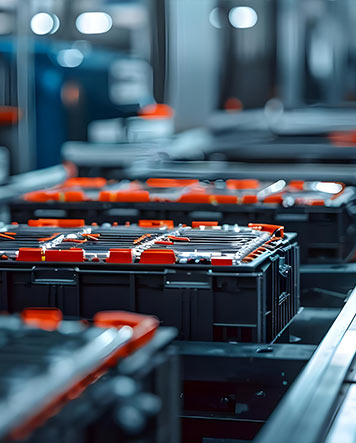The rapid growth of electric vehicles (EVs), renewable energy integration, and portable electronics has fueled an unprecedented demand for advanced battery solutions. From raw material processing to cell manufacturing, module assembly, and battery management systems (BMS), Programmable Logic Controllers (PLCs) and Distributed Control Systems (DCSs) play a critical role in automating and optimizing the entire battery production and utilization lifecycle. This article explores the diverse applications of PLCs and DCSs within the battery solutions landscape.
PLC Applications in Battery Manufacturing
PLCs are extensively used in the discrete automation aspects of battery manufacturing, controlling individual machines and processes with high precision and speed:
- Raw Material Processing:
- Mixing and Slurry Preparation: PLCs control the precise mixing of active materials, binders, and solvents to create the electrode slurry. This involves controlling agitators, pumps, and flow meters to ensure consistent material properties.
- Coating and Drying: PLCs regulate the coating process, applying the slurry onto metal foils (aluminum for cathodes, copper for anodes) with precise thickness control. They also manage the drying ovens, controlling temperature and airflow to remove solvents.
- Calendering: PLCs control the calendaring process, compressing the coated electrodes to achieve the desired density and porosity.
- Cell Assembly:
- Electrode Cutting and Stacking: PLCs control the precise cutting of electrodes into individual sheets and the automated stacking or winding of these sheets to form the cell structure.
- Electrolyte Filling: PLCs manage the precise dispensing of electrolyte into the cell, ensuring the correct amount and preventing leaks.
- Sealing and Welding: PLCs control the sealing and welding processes, creating a hermetically sealed cell enclosure.
- Formation and Aging: PLCs control the initial charging and discharging cycles (formation) and the subsequent aging process, which stabilizes the cell’s electrochemical properties.
- Module and Pack Assembly:
- Cell Sorting and Grading: PLCs integrate with testing equipment to sort and grade cells based on their performance characteristics.
- Cell Welding and Interconnection: PLCs control the welding or laser welding processes that connect individual cells to form modules and packs.
- BMS Integration: PLCs facilitate the integration of the Battery Management System (BMS) into the module or pack.
- Testing and Quality Control: PLCs control automated testing procedures to verify the performance and safety of modules and packs.
DCS Applications in Battery Manufacturing and Energy Storage
DCSs are employed for continuous process control, plant-wide integration, and overall system management in battery solutions:
- Large-Scale Slurry Preparation: For high-volume battery production, a DCS can manage the entire slurry preparation process, controlling multiple mixing tanks, ingredient dispensing systems, and quality monitoring instruments.
- Environmental Control: DCSs regulate temperature, humidity, and air quality within cleanrooms and dry rooms, which are critical for battery manufacturing.
- Energy Management in Manufacturing: DCSs monitor and optimize energy consumption throughout the battery manufacturing plant, identifying areas for improvement and reducing energy costs.
- Grid-Scale Energy Storage Systems (ESS): DCSs play a crucial role in managing large-scale battery energy storage systems connected to the electrical grid:
- Charge/Discharge Control: The DCS controls the charging and discharging of the battery system based on grid demand, renewable energy availability, and energy pricing.
- State of Charge (SOC) and State of Health (SOH) Monitoring: The DCS continuously monitors the SOC and SOH of the battery system, ensuring optimal performance and safety.
- Thermal Management: The DCS regulates the temperature of the battery system, preventing overheating and extending battery life.
- Grid Integration: The DCS facilitates the seamless integration of the battery system with the electrical grid, providing ancillary services such as frequency regulation and voltage support.
- Microgrid Control: DCSs can manage microgrids that incorporate battery storage, renewable energy sources (solar, wind), and local loads.
Hybrid Systems and Integration (PLCs and DCSs)
Similar to other industries, PLCs and DCSs are often integrated in battery solutions:
- PLC for Local Control: PLCs handle the fast, discrete control of individual machines and processes within the manufacturing line (e.g., coating, stacking, welding).
- DCS for Overall Coordination: The DCS oversees the entire production process, manages plant-wide utilities, and provides a unified platform for monitoring and control. In ESS applications, the DCS handles the overall system management and grid interaction.
- Data Exchange and Communication: PLCs and DCSs communicate with each other, exchanging data and coordinating operations. This ensures seamless information flow and optimized performance.
- MES/ERP Integration: Both PLCs and DCSs can be integrated with Manufacturing Execution Systems (MES) and Enterprise Resource Planning (ERP) systems, providing real-time data for production planning, scheduling, inventory management, and quality control.
Benefits of PLCs and DCSs in Battery Solutions
- Increased Production Efficiency: Automation reduces cycle times, increases throughput, and minimizes downtime in battery manufacturing.
- Improved Battery Quality and Consistency: Precise control and automated testing ensure consistent battery performance and reduce defects.
- Enhanced Safety: Automated systems reduce the risk of human error and improve workplace safety, particularly in handling hazardous materials.
- Optimized Energy Storage Performance: DCSs ensure the efficient and reliable operation of grid-scale and microgrid energy storage systems.
- Reduced Costs: Automation reduces labor costs, material waste, and energy consumption.
- Scalability: PLC and DCS systems can be easily scaled to accommodate increasing production demands or larger energy storage capacities.
- Data-Driven Decision Making: Real-time data from PLCs and DCSs provides valuable insights for process optimization, predictive maintenance, and continuous improvement.
Conclusion
PLCs and DCSs are indispensable technologies for the rapidly evolving battery solutions industry. They provide the automation, control, and integration capabilities needed to meet the growing demand for high-performance, reliable, and cost-effective batteries. From manufacturing to grid-scale energy storage, PLCs and DCSs are empowering the future of energy storage and enabling the transition to a more sustainable energy landscape. The trend towards hybrid systems and greater integration with MES/ERP will further enhance the efficiency and effectiveness of battery solutions.
 中文版
中文版






